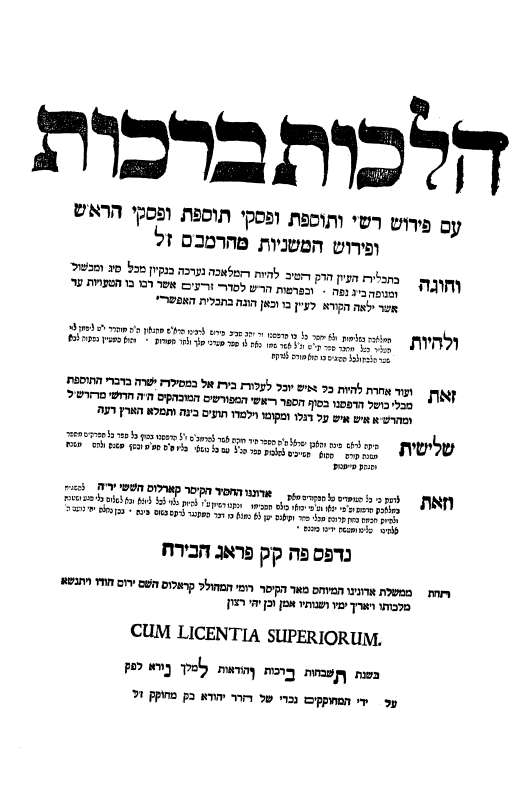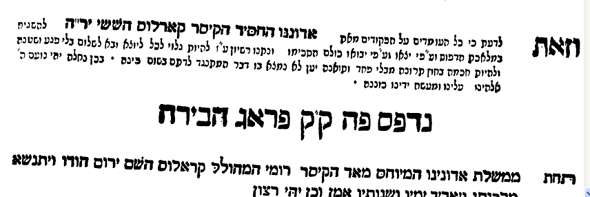In 1726 efforts to print a new edition of the Talmud were undertaken by elders of the city of Prague. This included getting permission of the Emperor, via the imperial censor of Hebrew books, Franz (Fransiscus) Haselbauer. Haselbauer was a Hebraist of some note, but a fervent Catholic and not exactly a partisan of free expression.
From the Jewish Encyclopedia entry on Confiscation of Hebrew Books:
About this same time another series of house-to-house searches was instituted in the city of Prague by a permanent Inquisition commission of Dominicans which had been established there. Certain books were found in the homes of forty-two families and were seized (1711). Still another search took place twelve years later under the Jesuit Franz Haselbauer.According to William Popper (Censorship of Hebrew Books pg. 112, citing other sources) the permanent inquisition commission in Prague consisted of three Jesuits, including Haselbauer, not Dominicans. Popper further writes (pg. 116) that Haselbauer enforced searches of Jewish homes for uncensored Jewish books, which would be confiscated. Because of the unusually harsh situation, Prague's Chief Rabbi David Oppenheim did not bring his amazing and famous library to Prague with him when he assumed office in 1702. Instead it remained in the custody of his father-in-law Leffmann Behrends in Hanover. It is in Hanover where Johann Christoph Wolf used this library to compile his Bibliotheca Hebraea.
Under these conditions Rabbi Jonathan Eybeschutz, then a young rabbi in Prague with the title Darshan, obtained permission from Haselbauer to print a heavily censored Talmud.
Here is the title page.

As you can see, the word "Talmud" does not appear. In fact the volume is euphemistically named "הלכות ברכות." Perhaps this is an allusion to the removed Aggadah in this volume, similar to the title of the Rif (Alfasi) - the הלכות. A note on the page reassuringly affirms לא נמצא בו דבר המתנגד לדתם בשום פינה, that there is nothing offensive to Christians in it:

Here are the cherubs on the first page:

Since you can download a pdf copy of this rare volume now, anyone can compare it with other editions to see what changes were made, but some samples were already given by Rabbi R.N.N. Rabinowicz on pg. 99 of his מאמר על הדפסת התלמוד. One omission noted is on page 6a. Below is a graphic comparison of a present edition to the 1728 one:

As you can see, a lengthy passage is simply missing. Here is the passage, with the missing part highlighted, followed by the Soncino translation:
Evidently the problem here is the how-to instructions for seeing demons rather than the discussion about them itself. Of course the relevant Rashi glosses are simply missing as well.תניא אבא בנימין אומר אלמלי נתנה רשות לעין לראות אין כל בריה יכולה לעמוד מפני המזיקין אמר אביי אינהו נפישי מינן וקיימי עלן כי כסלא לאוגיא אמר רב הונא כל חד וחד מינן אלפא משמאליה ורבבתא מימיניה אמר רבא האי דוחקא דהוי בכלה מנייהו הוי הני ברכי דשלהי מנייהו הני מאני דרבנן דבלו מחופיא דידהו הני כרעי דמנקפן מנייהו האי מאן דבעי למידע להו לייתי קיטמא נהילא ונהדר אפורייה ובצפרא חזי כי כרעי דתרנגולא האי מאן דבעי למחזינהו ליתי שלייתא דשונרתא אוכמתא בת אוכמתא בוכרתא בת בוכרתא ולקליה בנורא ולשחקיה ולימלי עיניה מניה וחזי להו ולשדייה בגובתא דפרזלא ולחתמי' בגושפנקא דפרזלא דילמא גנבי מניה ולחתום פומיה כי היכי דלא ליתזק רב ביבי בר אביי עבד הכי חזא ואתזק בעו רבנן רחמי עליה ואתסיIt has been taught: Abba Benjamin says, If the eye had the power to see them, no creature could endure the demons. Abaye says: They are more numerous than we are and they surround us like the ridge round a field. R. Huna says: Every one among us has a thousand on his left hand and ten thousand on his right hand. Raba says: The crushing in the Kallah lectures comes from them. Fatigue in the knees comes from them. The wearing out of the clothes of the scholars is due to their rubbing against them. The bruising of the feet comes from them. If one wants to discover them, let him take sifted ashes and sprinkle around his bed, and in the morning he will see something like the footprints of a cock. If one wishes to see them, let him take the after-birth of a black she-cat, the offspring of a black she-cat, the first-born of a first-born, let him roast it in fire and grind it to powder, and then let him put some into his eye, and he will see them. Let him also pour it into an iron tube and seal it with an iron signet that they should not steal it from him. Let him also close his mouth, lest he come to harm. R. Bibi b. Abaye did so, saw them and came to harm. The scholars, however, prayed for him and he recovered.
Rabinowicz notes that the passage about God wearing tefillin, א"ר אבין בר רב אדא א"ר יצחק מנין שהקב"ה מניח תפילין, is entirely missing. He only meant to give a sampler, so I will note another change on the very same page not mentioned by him. In the very passage after the demon-seeing-recipe, the Gemara says: תניא אבא בנימין אומר אין תפלה של אדם נשמעת אלא בבית הכנסת, It has been taught: Abba Benjamin says: A man's prayer is heard [by God] only in the Synagogue. I scarcely had to look to know that it would certainly not say this. Instead it says תניא אבא בנימין אומר תפלה של אדם נשמעת ביותר בבית הכנסת, A man's prayer [by God] is heard more in the Synagogue. My guess is that this version passed muster because although a zealous Christian censor could not have agreed with this, he certainly realized that at the end of it all the Jews believed in their own religion. Thus elevating a synagogue was not good, but understandable. But to mark it as the only place where prayer is heard was unacceptable. Alternatively, the Christians could have understood בית הכנסת in the sense of Church, but could not accept the idea that God only hears prayers in Church/ Synagogue. That it's a better place to pray was in consonance with Catholic theology (I think).
If these are the changes on only one ammud, there must be countless and I invite readers to find them. The shame of it all is that it is a beautiful, clear edition. In particular, its printing of the Rosh in square letters (similar to a page of Rif, surrounded by primary commentaries) is a pleasure.
Rabinowicz reports that when this edition appeared there was bitter anger all over Jewry, mainly out of fear that this would set a precedent for all other printings. At the prodding of Rabbis David Oppenheim and Moshe Chagiz, the Jews of Frankfurt A.M. bribed various officials in sum totalling 100,000 gold coins to put an end to this edition - although it will not be forgotten that the Prague edition would also compete with the Frankfurt edition published only a few years earlier and presumably still in print. According to R. Yaakov Emden (admittedly a hostile witness), in the end they succeeded in even extracting a royal decree to that effect. Apparently Rabbi Oppenheim had the license granted to Rabbi Eybeschutz revoked and personally forbade him from ever printing a Talmud.
Facts don't lie, but they also don't tell motivations. Alexander Putik noticed that church documents indicate that the project was not initiated by Eybeschutz which at the very least is not the way Rabbi Emden portrayed it. Furthermore, with such a watchful and zealous censor like Haselbauer the need for Talmuds in Prague was probably great. This must be why town leaders wished to print one, and realizing that this could only happen through censorship - the sober judgment of a great scholar - Eybeschutz - was appealed to for the censorship itself. Even though it is possible to interpret this favorably, or at least less negatively, perhaps people should bear this in mind when the worst aspersions are cast on rabbis, young or not, who err on the side of the less obviously frum thing to do. Sometimes there are good reasons for doing something, sometimes not so good reasons. But that doesn't mean in all cases that the person should never live it down. R. Yonasan Eybeschutz didn't desist from applying his scissor to the very Talmud itself when he was yet in this thirties, and this was hardly the worse thing he was ever accused of.
Here is R. Emden's record of it in his Hitabekut (Altona 1762):






Almost the whole Shas was printed in Prague between 1726 and 1741, when Eybeschutz left Prague for Metz. The Israel National Library has a copy of most of these volumes. Oppenheim died in 1736, so he did not revoke any permit.
ReplyDeleteIncidentally, Haselbauer authored a Hebrew dictionary that has an appendix of Yiddish terminolgy
Oppenheim didn't revoke any permit, for he didn't issue one. Rather, what is alleged is that he had Eybeschutz's permit revoked. The Shas itself wasn't a solo project, it was printed by Bak, etc. Indeed, Eybeschutz's name isn't even mentioned in the volume. Work itself began in 1726. Initially Haselbauer rejected it and further expurgations were made. It was printed in 1728, which is what the chronogram on the title page adds up: תבולנ = 488 = 1728 If the JNUL catalog has 1726 it is an error. I think he left Prague in 1733.
ReplyDeleteAlthough in his own writings he mentions relations with the Jesuits (itself the subject of controversy) if not for the fact that others, such as Emden and Chagiz (and dormant archival documents) mentioned his involvement it is possible that it would have been lost for posterity.
I read somewhere (maybe the book on individual tractates by Heller) that sometimes individual tractates were printed to evade censors. You know anything about that?
Hey, you cited the wrong Rabinowitz. You should have mentioned Dan, because those cherubs are no ordinary cherubs - they are RACY cherubs, and hence belong among the aforementioned's extensive collection of such imagery.
ReplyDeletePoint of the post well taken.
Great Post!
ReplyDeleteThis example is in fact mentioned in diqduqei sofrim
תניא אבא בנימין אומר תפלה של אדם נשמעת ביותר בבית הכנסת
Yes, interesting post. I nearly have a bad conscience to add a minor side point again: הלכות is just another term for gemore or Talmud, more concretely, "one heloche" is one page, or half a daf, in modern Yeshivish.
ReplyDelete